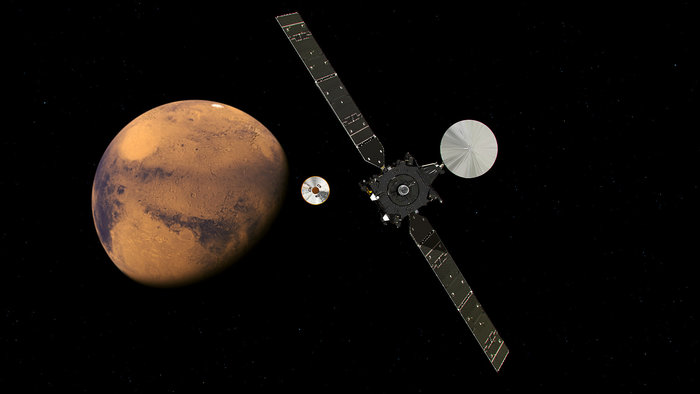ExoMars 2016 to enter the Red Planet’s orbit on October 19, 2016
ESA has announced the ExoMars 2016 mission is expected to enter the orbit of Mars on October 19, 2016, and has invited media representatives to attend the event at ESA's ESOC control center in Darmstadt, Germany.
The ExoMars program was established to investigate the environment of the Red Planet and demonstrate how the new technologies will pave the way for a future Mars sample return mission in the 2020's. The program encompasses two missions: the Trace Gas Orbiter (TGO), and an Entry, Descent, and landing demonstrator Module (EDM), named Schiaparelli, that were launched on March 14, 2016, and a mission, featuring a rover, planned for launch in 2020. Both missions will be carried out in cooperation with Roscosmos.

The ExoMars Trace Gas Orbiter and its entry, descent and landing demonstrator module, Schiaparelli, approaching Mars. The separation is scheduled to occur on 16 October 2016, about seven months after launch. Schiaparelli is set to enter the martian atmosphere on 19 October, while TGO will enter orbit around Mars. Image credit: ESA/ATG medialab
TGO is planned to conduct a detailed investigation of the Red planet's atmospheric gasses, especially methane, the existence of which implies an active, current source.
One of its goals is also to perform measurements of methane's geographical and seasonal dependence, and aid in discovering if its source is a geological or a biological one.
TGO's mission is planned to start at the end of 2017, after a year of complex aerobraking maneuvers to circularize the orbit. It is also planned to act as a relay for ESA's ExoMars 2020 rover.

Video credit: ESA/ATG medialab
ExoMars' Schiaparelli lander is expected to descend to the surface at the time of mission's orbit entrance. It will separate from TGO on October 16, and enter the atmosphere for a six-minute descent to a region in Meridiani Planum, on October 19.


Video credit: ESA/ATG medialab
The lander will conduct testing of a range of technologies to enable a controlled descent and landing on the planet, and prepare for future missions. Schiaparelli will measure the wind speed, humidity, pressure, and temperature at the place of landing, and obtain the first measurements of electric fields to investigate how the dust storms are formed on the planet.
Media representatives have been invited to follow the orbit insertion of TGO, and the Schiaparelli's landing. First descent camera images are expected on October 20, while the process of Schiaparelli's and TGO's separation will be covered online.
The event will be broadcasted over satellite, and streamed online here, on October 19 and 20. Also, ESA's social TV programme will be available via Facebook Live.
Featured image: The ExoMars Trace Gas Orbiter and its entry, descent and landing demonstrator module, Schiaparelli, approaching Mars. The separation is scheduled to occur on 16 October 2016, about seven months after launch. Schiaparelli is set to enter the martian atmosphere on 19 October, while TGO will enter orbit around Mars. Image credit: ESA/ATG mediala

Commenting rules and guidelines
We value the thoughts and opinions of our readers and welcome healthy discussions on our website. In order to maintain a respectful and positive community, we ask that all commenters follow these rules.